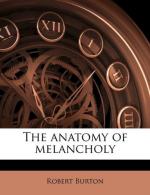Inwardly Taken,
Simples,
Roots,
Galanga, gentian, enula, angelica,
calamus aromaticus,
zedoary, china, condite ginger,
&c.
Herbs,
Pennyroyal, rue, calamint, bay leaves,
and berries,
scordium, bethany, lavender, camomile,
centaury,
wormwood, cumin, broom, orange
pills.
Spices,
Saffron, cinnamon, mace, nutmeg,
pepper, musk, zedoary
with wine, &c.
Seeds,
Aniseed, fennel-seed, ammi, cary,
cumin, nettle, bays,
parsley, grana paradisi.
or Compounds, as
Dianisum, diagalanga, diaciminum, diacalaminthes,
electuarium
de baccis lauri, benedicta laxativa,
&c. pulvia
carminativus, and pulvis descrip.
Antidotario Florentine,
aromaticum, rosatum, Mithridate.
or Outwardly used, as cupping-glasses
to the hypochonries without
scarification, oil of camomile, rue, aniseed,
their decoctions, &c.
THE SECOND PARTITION. THE CURE OF MELANCHOLY.
THE FIRST SECTION, MEMBER, SUBSECTION.
Unlawful Cures rejected.
Inveterate Melancholy, howsoever it may seem to be a continuate, inexorable disease, hard to be cured, accompanying them to their graves, most part, as [2789]Montanus observes, yet many times it may be helped, even that which is most violent, or at least, according to the same [2790]author, “it may be mitigated and much eased.” Nil desperandum. It may be hard to cure, but not impossible for him that is most grievously affected, if he but willing to be helped.
Upon this good hope I will proceed, using the same method in the cure, which I have formerly used in the rehearsing of the causes; first general, then particular; and those according to their several species. Of these cures some be lawful, some again unlawful, which though frequent, familiar, and often used, yet justly censured, and to be controverted. As first, whether by these diabolical means, which are commonly practised by the devil and his ministers, sorcerers, witches, magicians, &c., by spells, cabilistical words, charms, characters, images, amulets, ligatures, philters, incantations, &c., this disease and the like may be cured? and if they may, whether it be lawful to make use of them, those magnetical cures, or for our good to seek after such means in any case? The first, whether they can do any such cures, is questioned amongst many writers, some affirming, some denying. Valesius, cont. med. lib. 5. cap. 6. Malleus Maleficar, Heurnius, lib. 3. pract. med. cap. 28. Caelius lib. 16. c. 16. Delrio Tom. 3. Wierus lib. 2. de praestig. daem. Libanius Lavater de spect. part. 2. cap. 7. Holbrenner the Lutheran in Pistorium, Polydore Virg. l. 1. de prodig. Tandlerus, Lemnius, (Hippocrates and Avicenna amongst the rest) deny that spirits or devils have any power over us, and refer all with Pomponatius of Padua to natural causes and humours. Of the other opinion are Bodinus Daemonamantiae, lib. 3,




